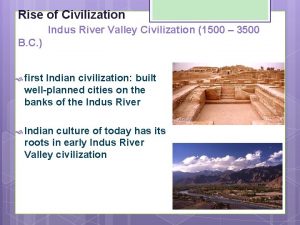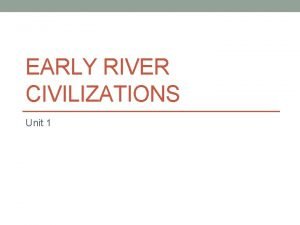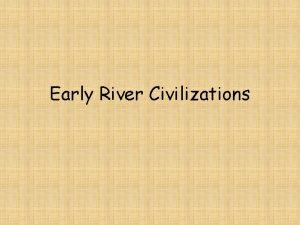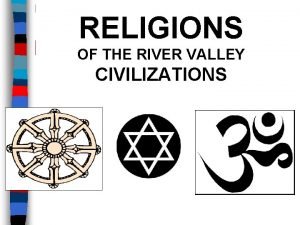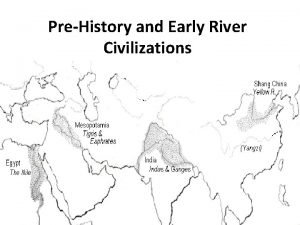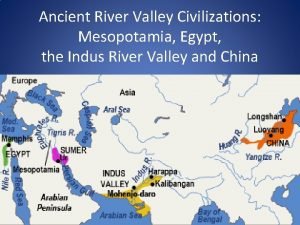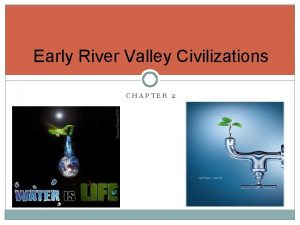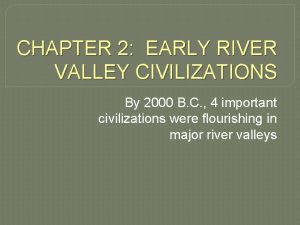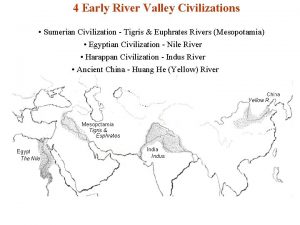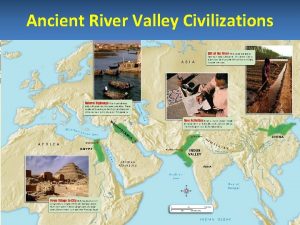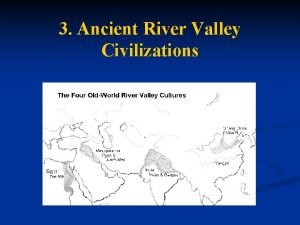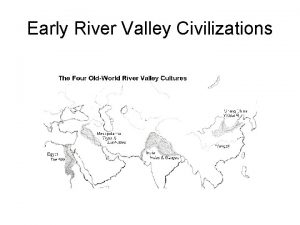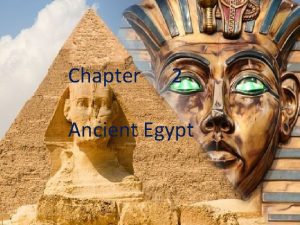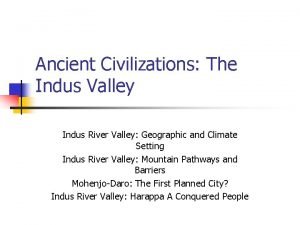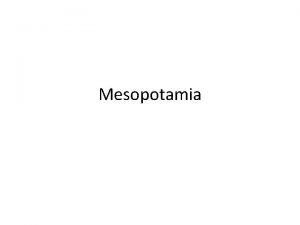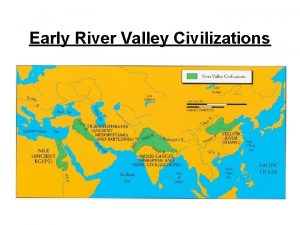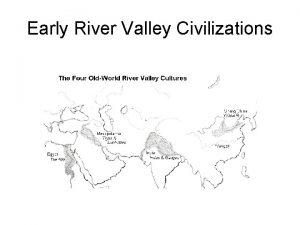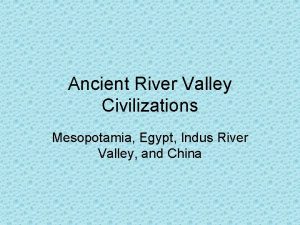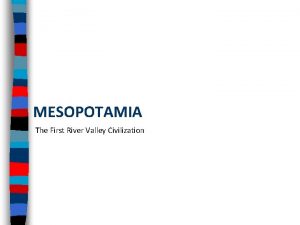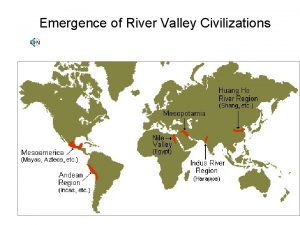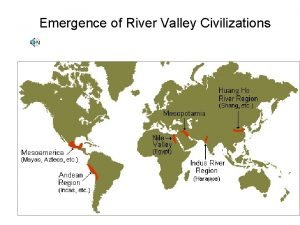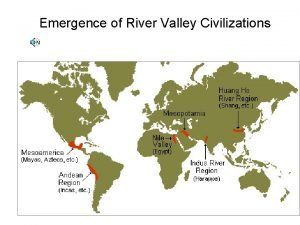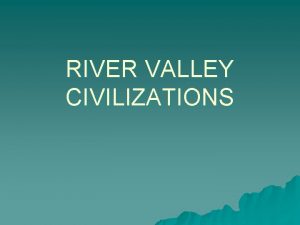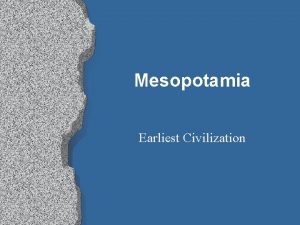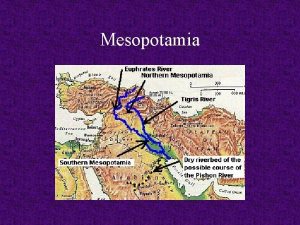RIVER VALLEY CIVILIZATIONS MESOPOTAMIA RIVER VALLEY CIVILIZATIONS The

















- Slides: 17

RIVER VALLEY CIVILIZATIONS MESOPOTAMIA

RIVER VALLEY CIVILIZATIONS The discovery of farming during the Neolithic Revolution allowed nomadic people to settle into villages and towns; these eventually became civilizations

Ancient Egypt The world’s first civilizations all began in river valleys Indus Valley The first civilization began in an area known as Mesopotamia China

The Tigris and Euphrates Rivers flooded once per year, leaving behind fertile soil ideal for farming (a perfect place to start a civilization) Mesopotamia means “land between the rivers” and is often called the “Fertile Crescent” or referred to as the “Cradle of Civilization”

The first civilization that developed in the “Fertile Crescent” of Mesopotamia was the kingdom of Sumer Surrounding deserts and the lack of natural barriers attracted outsiders to Mesopotamia and made the Sumerians vulnerable to attack; this led to other kingdoms rising in Mesopotamia

LASTING CONTRIBUTIONS ADVANCED CITIES: § Sumerian city-states were protected by high walls § At the city center was a temple called a ziggurat

LASTING CONTRIBUTIONS SPECIALIZED WORKERS: At the top of society were kings, and then priests In the middle were skilled workers, like merchants At the bottom, were common farmers and slaves

LASTING CONTRIBUTIONS (COMPLEX INSTITUTIONS) RELIGION: Sumerians and Babylonians were polytheistic (many gods)

LASTING CONTRIBUTIONS (COMPLEX INSTITUTIONS) RELIGION: The Hebrews in Palestine were the first monotheistic (single god) faith in history (Judaism. Jews) The holy book of Judaism is the Torah; God gave Moses the Ten Commandments which serve as moral laws

Sumerians Babylonians Assyrians Persians First Empire is created when King Hammurabi of Babylon takes over Sumer around 1700 BC. Stone carving of King Hammurabi This whole region is Mesopotamia, but by around 1000 BC the Assyrians take over much of the region.

LASTING CONTRIBUTIONS GOVERNMENT: Babylonian King Hammurabi created the first legal code Hammurabi’s Code had 282 laws based on justice and retaliation (for example: “an eye for an eye”) The code had different punishments for the various levels of society

LASTING CONTRIBUTIONS

LASTING CONTRIBUTIONS WRITING: Sumerians made the world’s first writing called cuneiform

WRITING: –Phoenicians simplified cuneiform to a 22 letter alphabet –Phoenician merchants spread the alphabet throughout the Mediterranean world –The alphabet influenced Greek, Latin, and English

Between 1000 – 500 BC mia pota o Mes

LASTING CONTRIBUTIONS TECHNOLOGY: Sumerian inventions include the wheel, sail, plow, and bronze metalwork

Closure Activity 1) Develop a “Hammurabi’s Code” for Cary/Raleigh/North Carolina: –Your code should include at least 5 laws and consequences –Think about things that are important to keep order. 2) How do your “Codes” compare to actual laws we have in America?
 Seasonal winds that dominate india's climate
Seasonal winds that dominate india's climate 4 river valley civilizations
4 river valley civilizations River valley civilizations map
River valley civilizations map Which cultures believe in reincarnation
Which cultures believe in reincarnation River valley civilizations map
River valley civilizations map River valley civilization map
River valley civilization map Chapter 2 early river valley civilizations
Chapter 2 early river valley civilizations Chapter 2 early river valley civilizations
Chapter 2 early river valley civilizations River valley civilizations vocabulary
River valley civilizations vocabulary 4 river valley civilizations
4 river valley civilizations Civilization ppt template
Civilization ppt template Yellow river civilization map
Yellow river civilization map River valley civilizations characteristics
River valley civilizations characteristics River valley civilizations definition
River valley civilizations definition 4 river civilizations
4 river civilizations River valley
River valley Imperial competition
Imperial competition Harappa
Harappa
